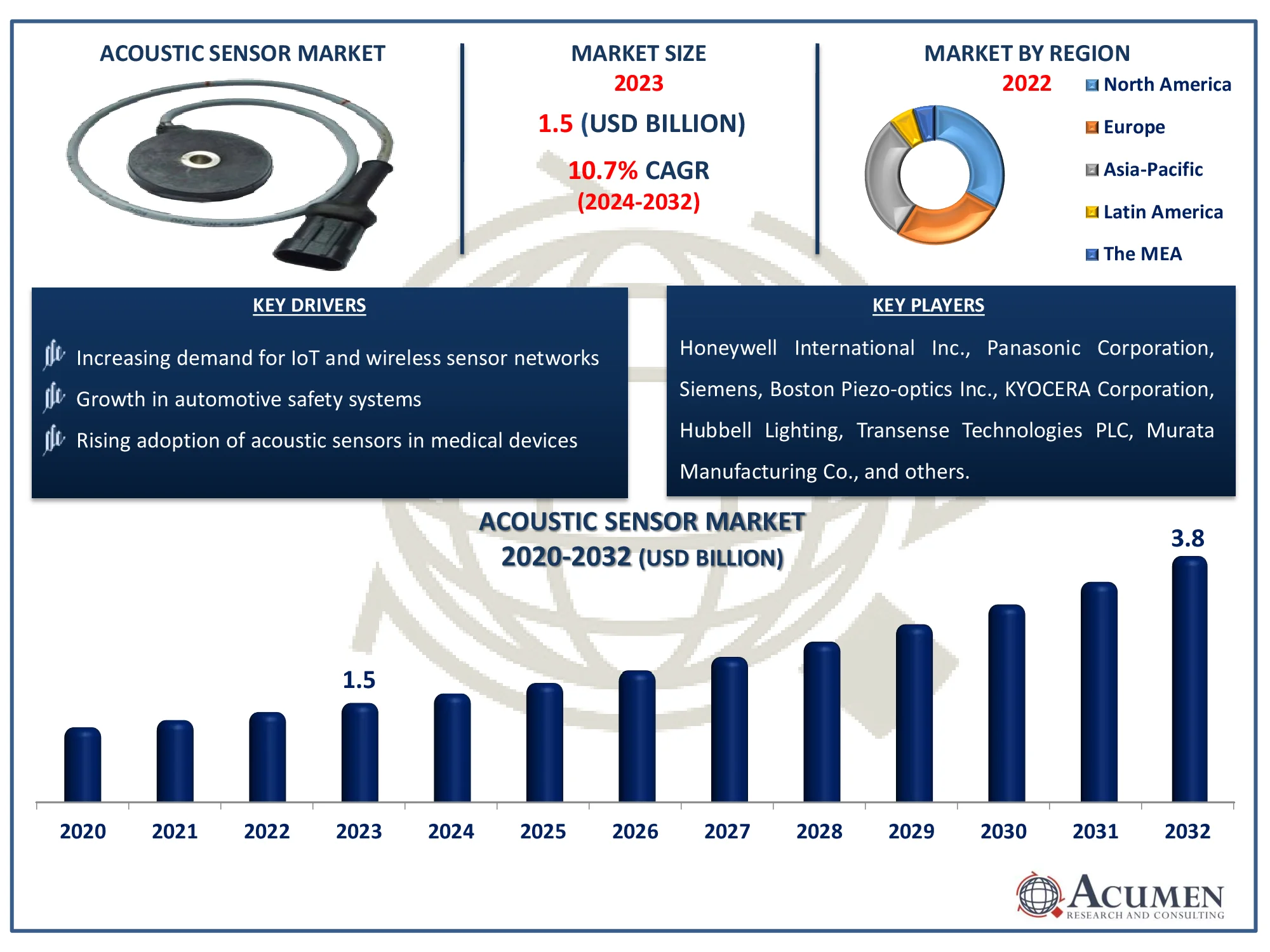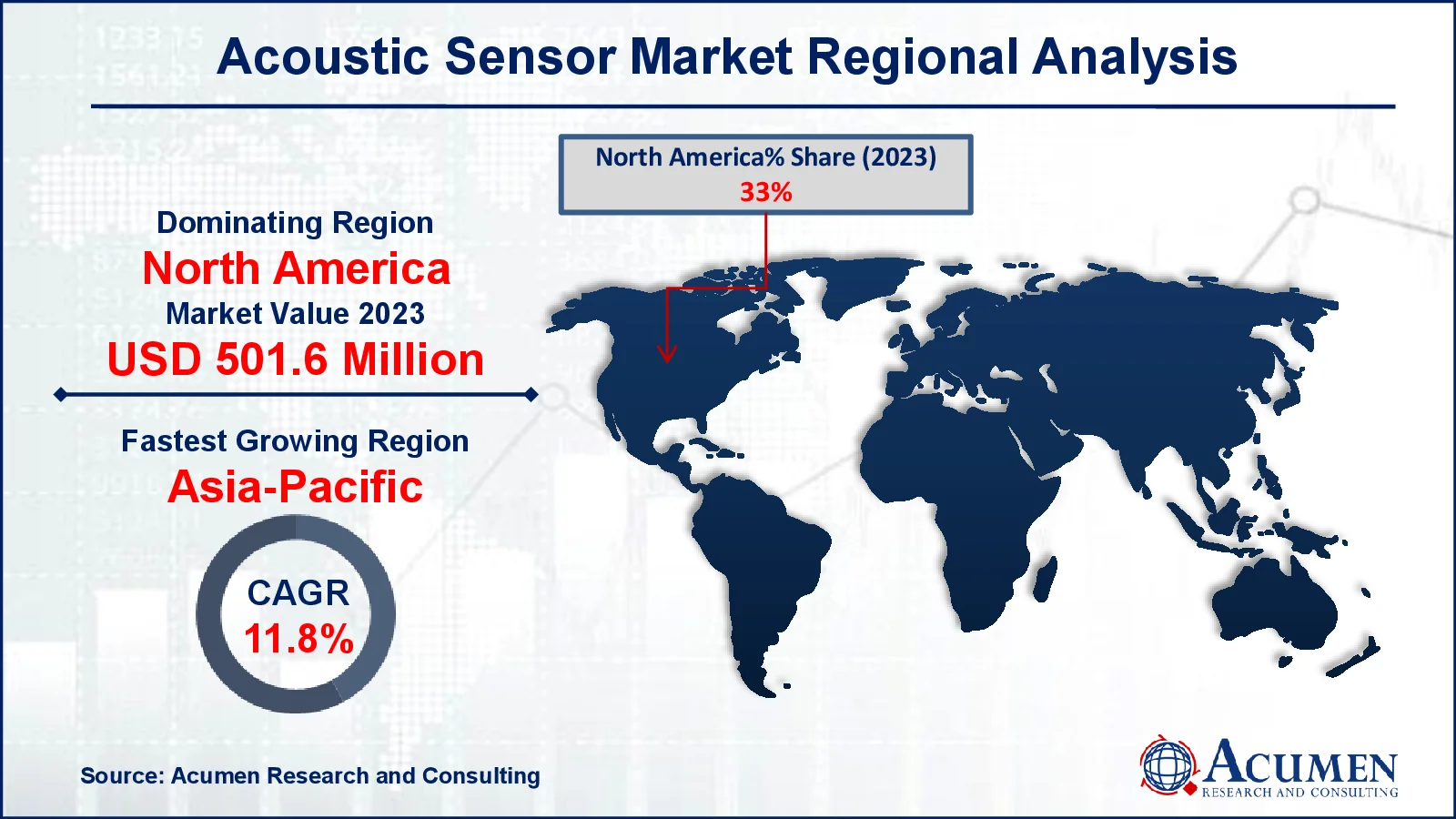Acoustic Sensor Market | Acumen Research and Consulting
Acoustic Sensor Market Size - Global Industry, Share, Analysis, Trends and Forecast 2024 - 2032
Published :
Report ID:
Pages :
Format :
The Global Acoustic Sensor Market Size accounted for USD 1.5 Billion in 2023 and is estimated to achieve a market size of USD 3.8 Billion by 2032 growing at a CAGR of 10.7% from 2024 to 2032.
Acoustic Sensor Market (By Wave Type: Surface Wave, and Bulk Wave; By Sensing Parameter: Pressure, Temperature, Humidity, Weight, Viscosity, Torque, and Others; By End-use Industry: Consumer Electronics, Automotive, Aerospace, Industrial, Healthcare, Defense, and Others and By Region: North America, Europe, Asia-Pacific, Latin America, and MEA)
Acoustic Sensor Market Highlights
- The global acoustic sensor market revenue is projected to reach USD 3.8 billion by 2032, with a CAGR of 10.7% from 2024 to 2032
- The North American acoustic sensor market was valued at approximately USD 501.6 million in 2023
- The Asia-Pacific acoustic sensor market is expected to grow at a CAGR of over 11.8% from 2024 to 2032
- The surface wave sub-segment accounted for 45% of the market share in 2023, based on wave type
- The pressure sub-segment held a significant market share in 2023, based on sensing parameters
- The trend towards smaller, more efficient acoustic sensors is driven by wearable and portable electronics demand is the acoustic sensor market trend that fuels the industry demand

Acoustic sensors detect sound waves and convert them into electrical signals that may be processed and analyzed. These sensors typically operate on piezoelectric, capacitive, or optical principles, allowing them to respond to changes in sound pressure. They are commonly used in industries to monitor and detect mechanical vibrations, structural integrity, and pressure changes. Applications include aerospace, automotive, healthcare, and environmental monitoring, where they are utilized for noise detection, ultrasonic imaging, and leak detection. Acoustic sensors are also used in consumer gadgets to recognize voices and provide sound-based interfaces. Their accuracy and dependability make them indispensable in modern sensing technology.
Global Acoustic Sensor Market Dynamics
Market Drivers
- Growth in automotive safety systems
- Increasing demand for IoT and wireless sensor networks
- Rising adoption of acoustic sensors in medical devices
Market Restraint
- High cost of production and installation
- Complex integration with existing systems
- Limited sensitivity in harsh environmental conditions
Market Opportunities
- Expanding applications in smart home devices
- Technological advancements in sensor miniaturization
- Growing demand for advanced sensors in aerospace and defense
Acoustic Sensor Market Report Coverage
| Market | Acoustic Sensor Market |
| Acoustic Sensor Market Size 2022 |
USD 1.5 Billion |
| Acoustic Sensor Market Forecast 2032 | USD 3.8 Billion |
| Acoustic Sensor Market CAGR During 2023 - 2032 | 10.7% |
| Acoustic Sensor Market Analysis Period | 2020 - 2032 |
| Acoustic Sensor Market Base Year |
2022 |
| Acoustic Sensor Market Forecast Data | 2023 - 2032 |
| Segments Covered | By Wave Type, By Sensing Parameter, By End-Use Industry, And By Geography |
| Regional Scope | North America, Europe, Asia Pacific, Latin America, and Middle East & Africa |
| Key Companies Profiled | Honeywell International Inc., Panasonic Corporation, Siemens, Boston Piezo-optics Inc., KYOCERA Corporation, Hubbell Lighting, Transense Technologies PLC, Murata Manufacturing Co., Pro-Micron GmbH & Co. Kg, AVX Corp., and others |
| Report Coverage |
Market Trends, Drivers, Restraints, Competitive Analysis, Player Profiling, Covid-19 Analysis, Regulation Analysis |
Acoustic Sensor Market Insights
The rapid progress of sensor technologies, as well as the widespread use of acoustic sensors in consumer electronics, is the primary drivers of the acoustic sensor market. In addition, an increase in government efforts and a rise in manufacturer expenditure in R&D activities are boosting the growth of the worldwide acoustic sensor market. The advancement of acoustic sensing technologies, as well as the increased acceptance of acoustic sensors in the automotive industry, will open up new prospects for manufacturers in the worldwide acoustic sensor market. For example, Frauscher Sensortechnik, an Austrian company, has added distributed acoustic sensing technology to its rail detection technologies product line in order to expand its business abroad.
Complex integration with existing systems becomes restraint for acoustic sensor market.
The complicated integration of acoustic sensors with current systems presents a substantial hurdle to industry expansion. Compatibility concerns with old infrastructure, as well as the requirement for considerable customization drive up implementation costs and complexity. This limits wider adoption, particularly in areas that require perfect sensor integration. Furthermore, specialized technical competence is frequently required, which limits market expansion.
Growing demand for advanced sensors in aerospace and defense creates a significant opportunity for acoustic sensor market. For instance, Honeywell announced in April 2024 that it has been chosen by Lilium, the developer of the first all-electric vertical takeoff and landing (eVTOL) plane, to provide propulsion unit position sensors for the Lilium plane. Honeywell created these sensors, termed as "resolvers," particularly to fulfill the Lilium Jet's unique requirements. They will be critical in properly identifying the engine's location, allowing the jet to safely reach the precise position required for a successful takeoff. This growing demand of advanced sensors in aerospace and defense industry further contributes to market growth in forecast year.
Acoustic Sensor Market Segmentation
The worldwide market for acoustic sensor is split based on wave type, sensing parameter, end-use industry, and geography.
Acoustic Sensor Wave Types
- Surface Wave
- FPW Sensors
- STW Sensors
- Rayleigh Surface Wave Sensors
- Bulk Wave
- SH-APM Sensor
- TSM Sensor
According to the acoustic sensor industry analysis, surface wave type leads the industry due to its high sensitivity and efficient signal propagation in sensing environmental changes. These sensors transform mechanical waves on the surface of materials into electrical signals, making them suitable for applications such as temperature, pressure, and chemical detection. Their low cost, low power consumption and compatibility with wireless systems have made them a popular choice in a variety of industries. Furthermore, surface wave acoustic sensors are extremely versatile, providing precision in a variety of demanding settings.
Acoustic Sensor Sensing Parameters
- Pressure
- Temperature
- Humidity
- Weight
- Viscosity
- Torque
- Others
The pressure sensing expected to show robust growth due to its vast use in the industrial, automotive, and healthcare industries. Acoustic sensors are extremely sensitive to pressure differences, making them excellent for monitoring systems like as tire pressure, airbag deployment, and ambient pressure changes. This capacity to detect slight pressure variations allows them a wide range of applications across multiple industries, driving demand. Furthermore, developments in microelectromechanical systems (MEMS) have improved their performance, increasing their popularity even further.
Acoustic Sensor End-use Industries
- Consumer Electronics
- Automotive
- Aerospace
- Industrial
- Healthcare
- Defense
- Others
According to the acoustic sensor market forecast, the automotive industry is expected to see notable growth in industry. This is primarily due to the growing use of acoustic sensors in applications including automotive safety systems, infotainment, and advanced driver-assistance systems (ADAS). These sensors are essential for monitoring tire pressure, detecting engine noise, and enhancing overall vehicle performance. As automotive technologies progress toward electrification and automation, the requirement for precise, dependable sensors grows.
Acoustic Sensor Market Regional Outlook
North America
- U.S.
- Canada
Europe
- U.K.
- Germany
- France
- Spain
- Rest of Europe
Asia-Pacific
- India
- Japan
- China
- Australia
- South Korea
- Rest of Asia-Pacific
Latin America
- Brazil
- Mexico
- Rest of Latin America
The Middle East & Africa
- South Africa
- GCC Countries
- Rest of the Middle East & Africa (ME&A)

Acoustic Sensor Market Regional Analysis
For several reasons, North America dominates the acoustic sensor market, owing to the region's significant technological breakthroughs and established industries. For instance, the ultraBAW RF filter is a new filter solution unveiled by Qualcomm in October 2021. The ultraBAW is designed to distinguish signals from 2.7 GHz to 7.2 GHz, enabling innovative 5G and Wi-Fi solutions. Qualcomm's ultraBAW and ultraSAW technology work together to offer a filter solution that covers a wide range of the radio spectrum. These filters round out Qualcomm's range of RF solutions, which includes its modem-to-antenna RF system The growing demand for wireless sensing technologies in the automotive, defense, and consumer electronics industries contributes to this dominance. Additionally, the region benefits from governmental policies that encourage the use of advanced sensing solutions.
The Asia-Pacific region is predicted to lead the global acoustic market due to the widespread use of acoustic sensor devices in the automotive and consumer electronics industries. China and Japan are likely to dominate the Asia-Pacific acoustic sensor market. Furthermore, the rising countries of Asia-Pacific are likely to provide profitable growth possibilities for important manufacturers. This aspect is expected to fuel the expansion of the acoustic sensor market.
Acoustic Sensor Market Players
Some of the top acoustic sensor companies offered in our report include Honeywell International Inc., Panasonic Corporation, Siemens, Boston Piezo-optics Inc., KYOCERA Corporation, Hubbell Lighting, Transense Technologies PLC, Murata Manufacturing Co., Pro-Micron GmbH & Co. Kg, AVX Corp., and others.
Frequently Asked Questions
How big is the acoustic sensor market?
The acoustic sensor market size was valued at USD 1.5 billion in 2023.
What is the CAGR of the global acoustic sensor market from 2024 to 2032?
The CAGR of acoustic sensor is 10.7% during the analysis period of 2024 to 2032.
Which are the key players in the acoustic sensor market?
The key players operating in the global market are including Honeywell International Inc., Panasonic Corporation, Siemens, Boston Piezo-optics Inc., KYOCERA Corporation, Hubbell Lighting, Transense Technologies PLC, Murata Manufacturing Co., Pro-Micron GmbH & Co. Kg, AVX Corp., and others.
Which region dominated the global acoustic sensor market share?
North America held the dominating position in acoustic sensor industry during the analysis period of 2024 to 2032.
Which region registered fastest CAGR from 2024 to 2032?
Asia-Pacific region exhibited fastest growing CAGR for market of acoustic sensor during the analysis period of 2024 to 2032.
What are the current trends and dynamics in the global acoustic sensor industry?
The current trends and dynamics in the acoustic sensor industry include increasing demand for IoT and wireless sensor networks, growth in automotive safety systems, and rising adoption of acoustic sensors in medical devices.
Which wave type held the maximum share in 2023?
The surface wave type held the maximum share of the acoustic sensor industry.



